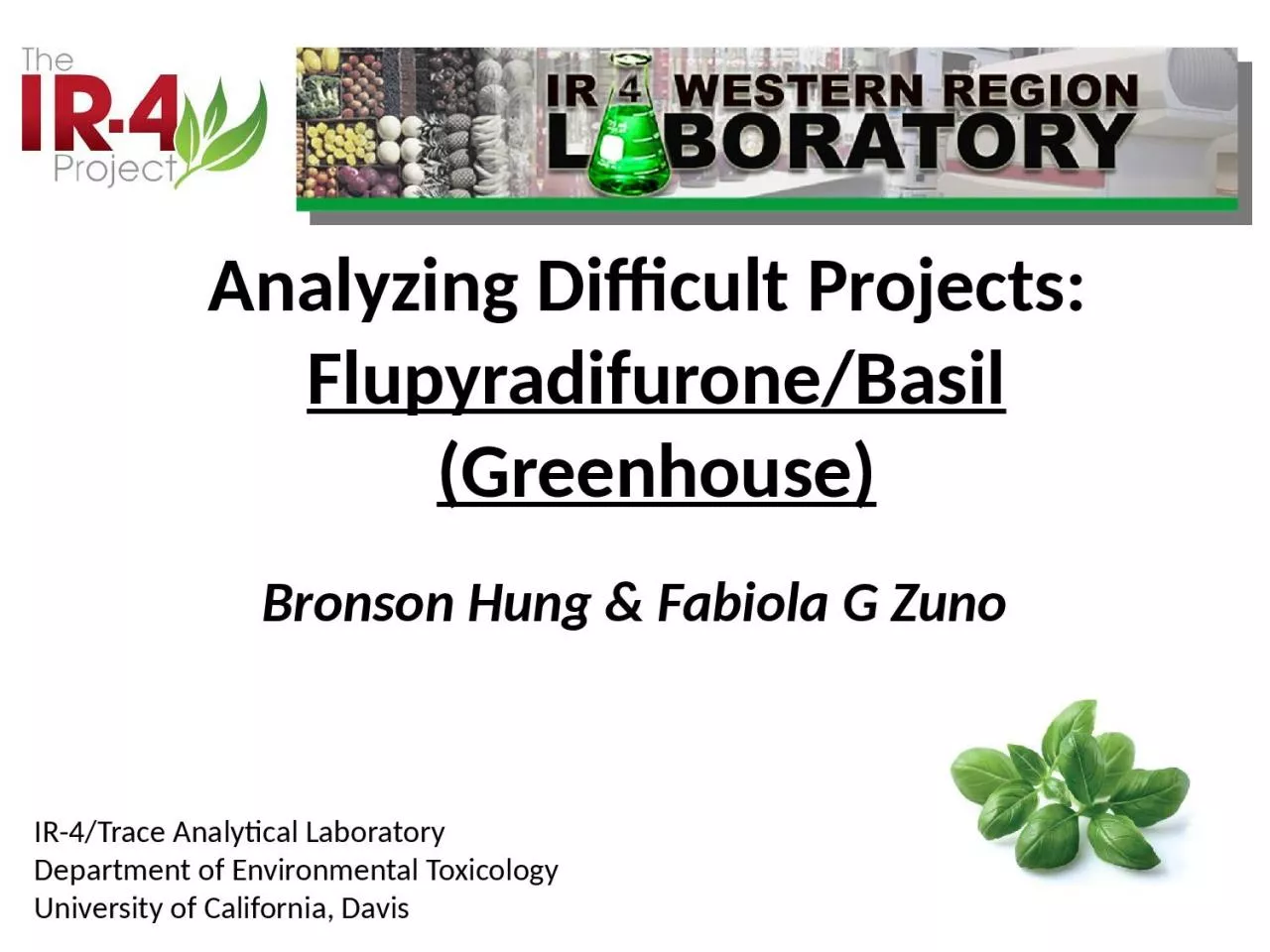

Department of Environmental Toxicology University of California Davis Analyzing Difficult Projects FlupyradifuroneBasil Greenhouse Bronson Hung amp Fabiola G Zuno Flupyrafidurone Basil Greenhouse ID: 1032665
Download Presentation The PPT/PDF document "IR-4/Trace Analytical Laboratory" is the property of its rightful owner. Permission is granted to download and print the materials on this web site for personal, non-commercial use only, and to display it on your personal computer provided you do not modify the materials and that you retain all copyright notices contained in the materials. By downloading content from our website, you accept the terms of this agreement.
1. IR-4/Trace Analytical LaboratoryDepartment of Environmental ToxicologyUniversity of California, DavisAnalyzing Difficult Projects: Flupyradifurone/Basil (Greenhouse)Bronson Hung & Fabiola G Zuno
2. Flupyrafidurone/Basil (Greenhouse)(PR# 12294)IR-4 Western Region Laboratory3 Treatments TRT#01 Untreated TRT#02 Foliar application (414mL/acre, 1X) TRT#03 Soil drench application or chemigation (828 mL/acre, 2X)4 Field Trials (PHI 0, 3-4, 6-7, 14 and 21 days). 3 field trials have decline on TRT #03 and 1 field trial has decline on both TRT #02 and #031 Crop Fraction (fresh stems & leaves). Total of 64 samples.Validate method for 6-CNA & DFA at 0.01ppm, 0.10ppm & 1.0 ppm in parent equivalent.
3. IR-4 Western Region LaboratoryFlupyradifurone (parent)MW: 288.7 g/molDifluoroacetic acid (DFA)MW: 96.0 g/mol(Parent Equivalent Ratio ~3)Three compoundsFortifiy in parent equivalent Example: 0.05ppm of DFA parent equivalent is equal to 0.017ppm of DFA6-Chloronicotinic acid (6-CNA)MW: 157.6 g/mol(Parent Equivalent Ratio ~2)
4. IR-4 Western Region LaboratoryReference Method:Bayer Method RV-001-P10-03. An Analytical Method for the Determination of Residues of BYI02960, 6-Chloronicotinic Acid, Difluoroacetic Acid, and Difluoroethyl-amino-fluranone in Plant Matrices Using LC/MS/MS.Validation for DFA:0.02ppm (in parent equivalent) in matrices with high water content.0.05ppm (in parent equivalent) in matrices with high protein, starch or oil content.
5. IR-4 Western Region LaboratoryComposition of basil:The chemical composition of O. basilicum essential oil differs according to the season. These essential oils have oxygenated monoterpenes (60.7–68.9%), followed by sesquiterpene hydrocarbons (16.0–24.3%) and oxygenated sesquiterpenes (12.0–14.4%). Around 29 compounds representing 98.0–99.7% of the oil composition have been reported . Linalool was the main constituent of essential oils (56.7–60.6%), followed by epi-α-cadinol (8.6–1.4%), α-bergamotene (7.4–9.2 (3. %), γ-cadinene 3–5.4%), germacrene D (1.1–3.3%), and camphor (1.1–3.1%). In addition, components like methylchavikol, methylcinnamat, linolen, eugenol, camphor, cis-geraniol, 1,8-cineole, α-bergamotene, β-caryophyllene, germacrene D, γ-cadinene, epi-α-cadinol, and viridiflorol have been reported as important components.Source of:FiberVitamins (beta-carotene, thiamine B1, riboflavin B2, niacin B3, pantothenic acid B5, vitamin B6, folate B9, choline, vitamin C, vitamin E and vitamin K).Minerals (calcium, copper, magnesium, manganese, phosphorus, potassium, selenium, sodium and zinc).M.L. Chavez-Gonzalez, R. Rodriguez-Herrera, C.N. Aguilar (2016) Essential Oils: A Natural Alternative to Combat Antibiotics Resistance . ScienceDirect , pages 227-237
6. IR-4 Western Region LaboratoryExtraction:Reference Method: 5.0 g of frozen sample10-25 mL of acidified 4:1 acetonitrile:water (v/v)Blend for 1 min using a blenderFilter the sampleExtract filter cake with 10-25 mL of extraction solventAdjust the volume to 50 mL with extraction solventWorking Method: 2.0 g of frozen sample10 mL of extraction solventGeno Grinder (1min at 1000rpm) Centrifuge (5mins at 4000rpm) Adjust the volume to 20 mL
7. IR-4 Western Region LaboratoryOriginal plan:Common extraction for parent and metabolites and analyze them togetherCommon cleanup for three compounds Analyze three compounds together
8. IR-4 Western Region LaboratoryFlupyradifurone cleanup:Working method:No internal standardC18 (1g/6mL) & Carbon (200 mg/6mL) . Quantifier ion 90.1 m/z. A background in all control samples of basil was observed with the ion 125.9 m/z.Reference method:Internal StandardC18 SPE (1g/6mL)Quantifier ion 125.9 m/zApplied Biosystems API 4000 & 5500 Mass SpectrometerLC-Column: SeQuant Zic-Hilic (4.6x150 mm, 5 µm packing) or Phenomenex Germini C18 (2.0x150 mm, 5 µm packing) LC-Column: ZORBAX SB-C18 (2.1x50mm, 1.8 µm packing), AgilentAgilent 6430 LC-MS/MS
9. IR-4 Western Region Laboratory6-CNA and DFA’s cleanup:SPEs tested:Strata-X (500mg/6 mL)Strata- SCX (500mg/6 mL)C18 (1g/6mL)Carbon (200 mg/6mL)HAX (1g/6mL)WAX (500 mg/6mL)SAX (2 g/12 mL)Silica (1g/6 mL)NH2 (500mg/6mL)Individually and in combinationWith and w/out sampleSUPPRESSION was observed for 6-CNA and DFA
10. IR-4 Western Region LaboratoryStep #1:5 mL aliquot (equivalent to 0.50 g of crop material)Evaporation of acetonitrile at 50°C for ~18 min at 12 psiLiquid-liquid partition with 5 mL of hexane (2X) Organic layer with non-polar compounds Aqueous layer with 6-CNA and DFADiscard layer
11. IR-4 Western Region LaboratoryStep #2:Liquid-liquid partition with 5 mL of dichloromethane (DCM, 3X)6-CNADFADFA remains in the aqueous phase across the range of tested pH values (2-9.5).
12. IR-4 Western Region Laboratory6-CNA cleanup:Evaporate the DCM to drynessDissolve the sample in 10mL of ethyl acetate/hexane (50/50, v/v)Wash the SPE with one column volume (CV) of ethyl acetate/hexane (50/50, v/v) and then ethyl acetate/hexane (80/20, v/v)Wash the SPE with 2 CVs of 100% acetoneElute residues of 6-CNA with 9 mL of methanol/acetone (50/50, v/v) LC-column: Phenyl-Hexyl, ZORBAX Eclipse Plus (2.1x100mm, 3.5 µm packing), AgilentAgilent 6460 LC-MS/MS
13. IR-4 Western Region LaboratoryDFA cleanup:Alumina (aluminum oxide) A, B & NActivated and deactivatedConditioned and unconditionedPack column with 1-5 mL of alumina B (2 mL)Load the sample onto the column in acetonitrile:water (50/50, v/v)LC-column: Phenyl-Hexyl, ZORBAX Eclipse Plus (3.0x150mm, 2.7 µm packing), AgilentAgilent 6460 LC-MS/MS
14. IR-4 Western Region LaboratoryCompoundsRecoveries (%)0.01/0.05* ppm0.1ppm1.0ppm5.0ppmFlupyradifurone83-106(n=6)82-98(n=4)93-96(n=4)89-91(n=3)6-CNA74 -120(n=6)74-87(n=8)70-78(n=3)*DFA79-104(n=6)69-106(n=8)73-78(n=3)Sets: Validation, WI381, OH*272 & CA77
15. IR-4 Western Region LaboratoryThank you